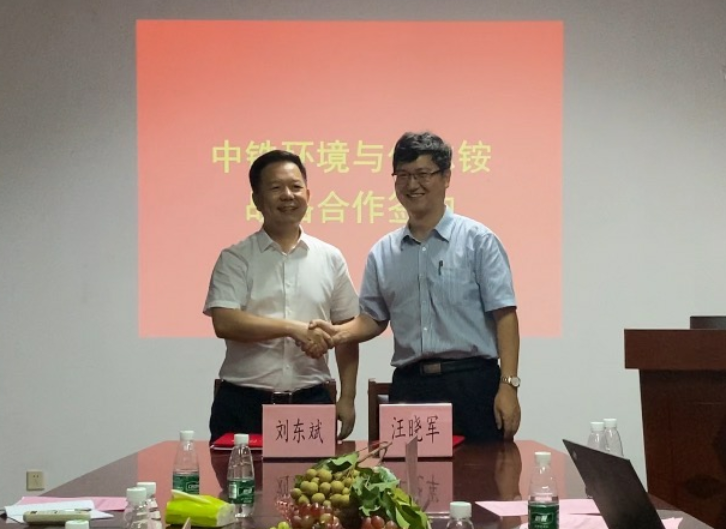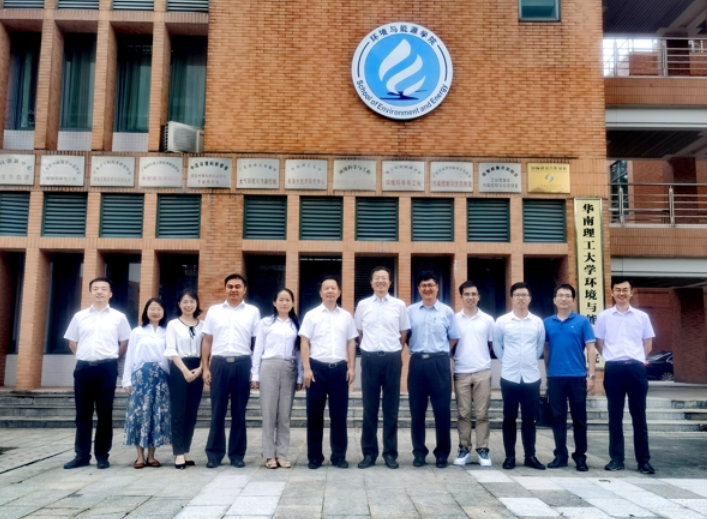

On the afternoon of August 14, Professor Xiaojun, Wang’s team and China Railway Environment and Technology Engineering Co., Ltd. (hereinafter referred to as 'China Railway Environment') signed a strategic cooperation agreement in the Environmental Building of the Higher Education Mega Center campus to expand the use of anaerobic ammonia oxidation technology in domestic high-speed rail train wastewater. Professor Ye Daiqi, Dean of School of Environment and Energy of South China University of Technology, Professor Wang Xiaojun and his team members, General Manager of China Railway Environment Liu Dongbin, Deputy Chief Engineer of China Railway Environment Yan Haiyan, Minister of Planning and Development Department of China Railway Environment Zhang Zhao and relevant department heads of China Railway Environment, Chief of Development Department of the South China University of Technology Science Park Achievement Transformation Office Zi Zhihong, and General Manager of Guangzhou Hualv Environment and Technology Co., Ltd. Gu Xiaoyang attended the signing ceremony.

Dean Ye Daiqi welcomed the visit of China Railway Environment. He pointed out that China Railway Environment is a fast-growing technological and manufacturing enterprise, and hoped to develop professional talent training with China Railway Environment based on the foundation of preliminary cooperation, further expand cooperation fields, and establish a long-term, comprehensive, deep-level cooperation. Subsequently, Liu Dongbin, general manager of China Railway Environment, introduced China Railway Environment from aspects of corporate development vision, strategic positioning and main business. He reviewed the good memories of the exchanges between China Railway Environment and the scientific research team of the School of Environment and Energy of South China University of Technology, and pointed out the good cooperation prospects of the two parties in three aspects of technology joint research and development, scientific and technological achievements transformation and high-end talent training. And he hoped that through this cooperation, the innovation chain of 'production, learning, research, and use' could be open up to set a new model for school-enterprise cooperation. Zi Zhihong, Chief of Development Department of the South China University of Technology Science Park Achievement Transformation Office, introduced the basic situation of the transformation of scientific and technological achievements and business incubation in the National University Science Park of South China University of Technology. He pointed out that Professor Wang Xiaojun’s team is one of the most representative teams in the transformation of environmental technology achievements in the university. The established Foshan Huaer’an Biotechnology Co., Ltd. is a typical outstanding enterprise incubated by the National University Science Park of South China University of Technology, and expressed gratitude to both parties for their contribution to the transformation of South China University of Technology's scientific and technological achievements. Finally, Professor Wang Xiaojun introduced the process of anammox technology developed by the team and said that in this cooperation with China Railway Environment, both parties would give full play to their respective advantages to further enhance scientific and technological innovation capabilities and accelerate the output of scientific and technological achievements.

The signing of this cooperation agreement is the in-depth and implementation of the previous cooperation agreement signed between China Railway Environment and the School of Environment and Energy of South China University of Technology. It represents that the two parties will jointly promote the lowest carbon and energy-saving anaerobic ammonia oxidation biological denitrification technology to the treatment of wastewater of domestic high-speed rail and deepen cooperation in the development, integration and application expansion of new technologies and equipment. It also represents that the two parties will work together to accelerate the transformation, promotion and application of scientific and technological achievements, and create good social, environmental and economic benefits.




